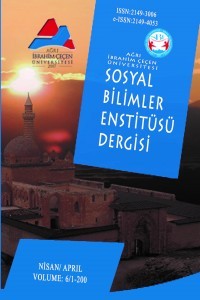RETRACTION NOTİCE FOR FROM HISTORICAL AND SOCIOLOGICAL REALITY TO VIRTUALITY OF THE DIGITAL AGE: VIRTUALIZATION OF THE COMMUNITY
‘Community’ is the social unit in which man, who is a social being, has been present since the first days of human history. It is generally the family, village, neighborhood and relatives. However, new communities and identities, which are increasingly dominated by global elements, are constantly emerging in the world. They are usually formations that give the impression of factitious and false communities. The virtual community is the most well-known one among these formations. However, they cannot take the place of traditional communities. In this new environment, the people entering into new forms of relationship constitute an alternative virtual culture by identifying their own rules and behavior within these virtual groups. The boundaries or content of this culture is determined by the members of the virtual community. The cultural elements that are determined are transmitted to the members of the virtual community through a language peculiar to the internet. This research aims to determine the conditions under which virtual communities are formed, what the characteristics of the general course of the formation process are and what their functions are. The existing literature has been examined in detail in the context of the issue.
RETRACTION NOTİCE FOR FROM HISTORICAL AND SOCIOLOGICAL REALITY TO VIRTUALITY OF THE DIGITAL AGE: VIRTUALIZATION OF THE COMMUNITY
‘Community’ is the social unit in which man, who is a social being, has been present since the first days of human history. It is generally the family, village, neighborhood and relatives. However, new communities and identities, which are increasingly dominated by global elements, are constantly emerging in the world. They are usually formations that give the impression of factitious and false communities. The virtual community is the most well-known one among these formations. However, they cannot take the place of traditional communities. In this new environment, the people entering into new forms of relationship constitute an alternative virtual culture by identifying their own rules and behavior within these virtual groups. The boundaries or content of this culture is determined by the members of the virtual community. The cultural elements that are determined are transmitted to the members of the virtual community through a language peculiar to the internet. This research aims to determine the conditions under which virtual communities are formed, what the characteristics of the general course of the formation process are and what their functions are. The existing literature has been examined in detail in the context of the issue.
___
- Akkaş, İ. (2015). Sanal cemaatler, İstanbul: Doğu Kütüphanesi.
- Anderson, B. (2004). Imagined communities: reflections on the origin and
spread of nationalism, (Translated by: İ. Savaşır), İstanbul: Metis
Publications.
- Barry, W. & Gulia, M. (1997). Virtual communities as communities, net
surfers doıı’t ride alone. Communities in cyberspace. (Edt. M. A.
Smith & P. Kollock), London: Routledge, (167-193).
- Baudrillard, J. (1998). Le Crime Parfait, (Translated by: N. Sevil). İstanbul:
Ayrıntı Publications.
